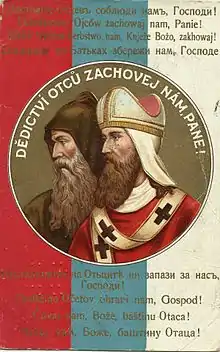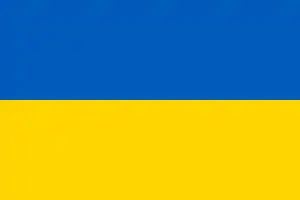Christianization of the Slavs
The Slavs were Christianized in waves from the 7th to 12th century, though the process of replacing old Slavic religious practices began as early as the 6th century.[1] Generally speaking, the monarchs of the South Slavs adopted Christianity in the 9th century, the East Slavs in the 10th, and the West Slavs between the 9th and 12th century. Saints Cyril and Methodius (fl. 860–885) are attributed as "Apostles to the Slavs", having introduced the Byzantine-Slavic rite (Old Slavonic liturgy) and Glagolitic alphabet, the oldest known Slavic alphabet and basis for the Early Cyrillic alphabet.

Slavic Christianity
Slavic Christianity refers to the history of Christianity among the Slavic peoples. The Slavic nations (or ethnic groups) are divided between Eastern Orthodoxy and Roman Catholicism. The Orthodox Slavs use the Cyrillic script, while the Catholic Slavs use the Latin script. Orthodox Slavs used the Slavic languages for liturgy from 863, firstly in Great Moravia and Bulgaria, while Catholic Slavs (like other Catholics) have only done so since the Counter-Reformation.
States
 Belarus, plurality Eastern Orthodox (Russian Orthodox Church), minority Roman Catholic
Belarus, plurality Eastern Orthodox (Russian Orthodox Church), minority Roman Catholic Bosnia and Herzegovina, predominantly Eastern Orthodox (Serbian Orthodox Church), minority Roman Catholic
Bosnia and Herzegovina, predominantly Eastern Orthodox (Serbian Orthodox Church), minority Roman Catholic Bulgaria, predominantly Eastern Orthodox (Bulgarian Orthodox Church), minority Roman Catholic
Bulgaria, predominantly Eastern Orthodox (Bulgarian Orthodox Church), minority Roman Catholic Croatia, predominantly Roman Catholic, minority Eastern Orthodox (Serbian Orthodox Church)
Croatia, predominantly Roman Catholic, minority Eastern Orthodox (Serbian Orthodox Church) Czech Republic, traditionally Roman Catholic and Hussite, today mostly irreligious[2]
Czech Republic, traditionally Roman Catholic and Hussite, today mostly irreligious[2] Serbia, predominantly Eastern Orthodox (Serbian Orthodox Church), minority Roman Catholic[3]
Serbia, predominantly Eastern Orthodox (Serbian Orthodox Church), minority Roman Catholic[3] Slovakia, predominantly Roman Catholic, minority Evangelical Church of the Augsburg Confession in Slovakia and Slovak Greek Catholic Church
Slovakia, predominantly Roman Catholic, minority Evangelical Church of the Augsburg Confession in Slovakia and Slovak Greek Catholic Church Slovenia, predominantly Roman Catholic, minority Eastern Orthodox (Serbian Orthodox Church)
Slovenia, predominantly Roman Catholic, minority Eastern Orthodox (Serbian Orthodox Church) North Macedonia, majority Eastern Orthodox (Ohrid Archbishopric), minority Serbian Orthodox Church
North Macedonia, majority Eastern Orthodox (Ohrid Archbishopric), minority Serbian Orthodox Church Montenegro, predominantly Eastern Orthodox (Serbian Orthodox Church), minority Montenegrin Orthodox Church
Montenegro, predominantly Eastern Orthodox (Serbian Orthodox Church), minority Montenegrin Orthodox Church Poland, predominantly Roman Catholic, minority Eastern Orthodox (Polish Orthodox Church)
Poland, predominantly Roman Catholic, minority Eastern Orthodox (Polish Orthodox Church) Russia, majority Eastern Orthodox (Russian Orthodox Church)
Russia, majority Eastern Orthodox (Russian Orthodox Church) Ukraine, majority Eastern Orthodox (Ukrainian and Russian), minority Ukrainian Greek Catholic Church
Ukraine, majority Eastern Orthodox (Ukrainian and Russian), minority Ukrainian Greek Catholic Church
See also
- Christianization of Bulgaria (864)
- Christianization of Moravia (863)
- Christianization of Serbs (accounted Christian as of about 870[4])
- Christianization of Bohemia (884)
- Christianization of Poland (966)
- Christianization of Kievan Rus' (988)
- Christianization of Pomerania (1124)
- Slavic paganism
- Eastern Orthodoxy in Europe
- Catholic Europe
- Christianisation of the Germanic peoples
Orthodoxy
Catholicism
References
- Białous, Mirosław (2016-12-01). "Religion of the Proto-Slavs". Elpis. 0 (18). ISSN 1508-7719.
- (PDF). 2015-02-21 https://web.archive.org/web/20150221184947/http://www.czso.cz/sldb2011/eng/redakce.nsf/i/tab_7_1_population_by_religious_belief_and_by_municipality_size_groups/$File/PVCR071_ENG.pdf. Archived from the original (PDF) on 2015-02-21. Retrieved 2020-07-11. Missing or empty
|title=(help) - Doe, John (2017-10-10). "Population: Demographic Situation, Languages and Religions". Eurydice - European Commission. Retrieved 2020-07-11.
- Vlasto 1970, p. 208.
Sources
- Moravcsik, Gyula, ed. (1967) [1949]. Constantine Porphyrogenitus: De Administrando Imperio (2nd revised ed.). Washington D.C.: Dumbarton Oaks Center for Byzantine Studies. ISBN 9780884020219.
- Nora Berend (2007). Christianization and the Rise of Christian Monarchy: Scandinavia, Central Europe and Rus' c.900–1200. Cambridge University Press. ISBN 978-1-139-46836-7.
- Curta, Florin (2006). Southeastern Europe in the Middle Ages, 500–1250. Cambridge: Cambridge University Press. ISBN 978-0-521-81539-0.
- Augustine Casiday (2012). The Orthodox Christian World. Routledge. ISBN 978-1-136-31484-1.
- Thomas John Drobena; Wilma Samuella Kucharek (1979). Heritage of the Slavs: The Christianization of the Slavs and the Great Moravian Empire. Kosovo Publishing Company.
- Francis Dvornik (1962). The Slavs in European History and Civilization. Rutgers University Press. ISBN 978-0-8135-0799-6.
- Fine, John V. A. Jr. (1991) [1983]. The Early Medieval Balkans: A Critical Survey from the Sixth to the Late Twelfth Century. Ann Arbor, Michigan: University of Michigan Press. ISBN 0-472-08149-7.
- B. Gasparov; Olga Raevsky-Hughes (1995). Christianity and the Eastern Slavs: Slavic cultures in the Middle Ages. University of California Press. ISBN 978-0-520-07945-8.
- Komatina, Predrag (2015). "The Church in Serbia at the Time of Cyrilo-Methodian Mission in Moravia". Cyril and Methodius: Byzantium and the World of the Slavs. Thessaloniki: Dimos. pp. 711–718.
- Vlasto, Alexis P. (1970). The Entry of the Slavs into Christendom: An Introduction to the Medieval History of the Slavs. Cambridge: Cambridge University Press. ISBN 9780521074599.
- Živković, Tibor (2007). "The Golden Seal of Stroimir" (PDF). Historical Review. Belgrade: The Institute for History. 55: 23–29. Archived from the original (PDF) on 2018-03-24. Retrieved 2018-03-07.
- Živković, Tibor (2008). Forging unity: The South Slavs between East and West 550-1150. Belgrade: The Institute of History, Čigoja štampa. ISBN 9788675585732.
- Živković, Tibor (2012). De conversione Croatorum et Serborum: A Lost Source. Belgrade: The Institute of History.
- Živković, Tibor (2013). "On the Baptism of the Serbs and Croats in the Time of Basil I (867–886)" (PDF). Studia Slavica et Balcanica Petropolitana (1): 33–53.
- B. Gasparov; Olga Raevsky-Hughes (1995). Christianity and the Eastern Slavs: Slavic cultures in the Middle Ages. University of California Press. ISBN 978-0-520-07945-8.
- Thomas John Drobena; Wilma Samuella Kucharek (1979). Heritage of the Slavs: The Christianization of the Slavs and the Great Moravian Empire. Kosovo Publishing Company.
- Živković, Tibor (2008). Forging unity: The South Slavs between East and West 550-1150. Belgrade: The Institute of History, Čigoja štampa. ISBN 9788675585732.
